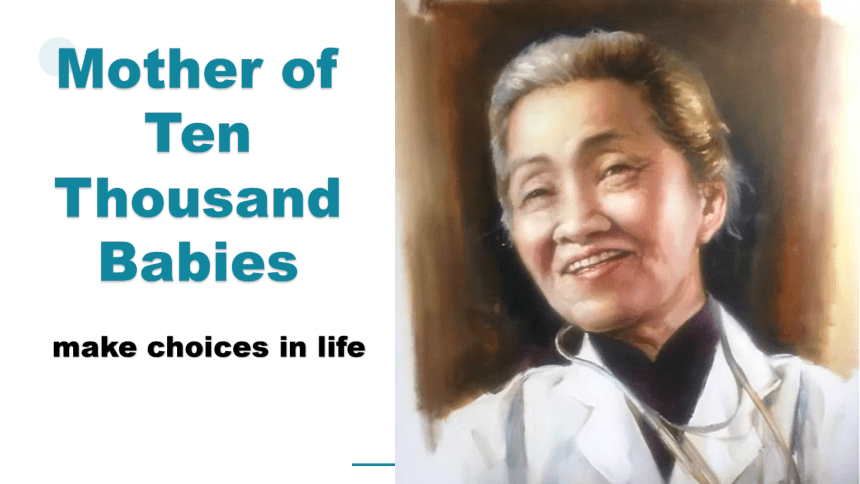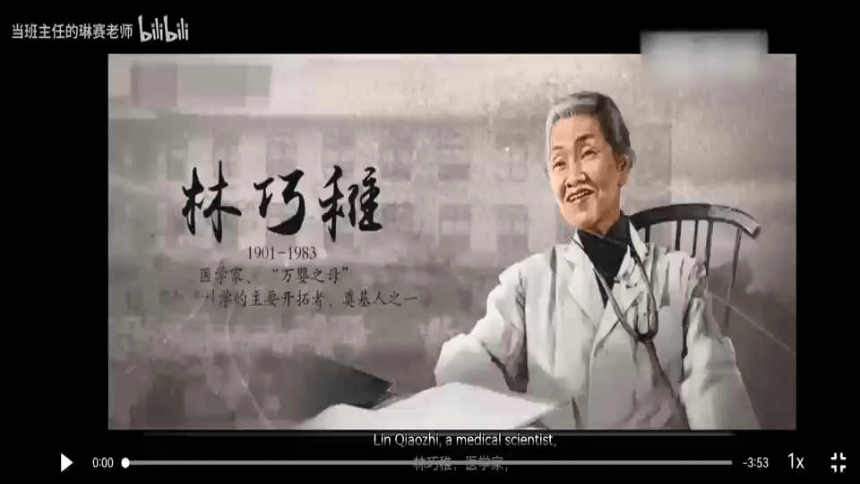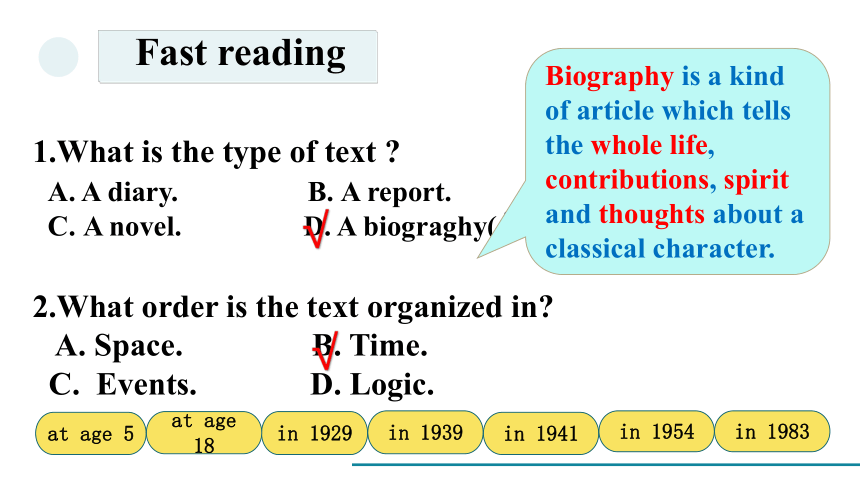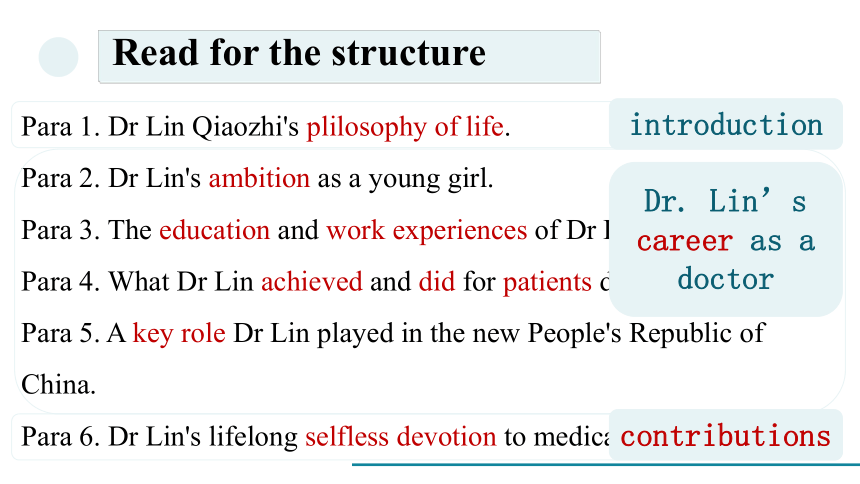Unit 2 Morals and Virtue reading and thinking 万婴之母林巧稚 课件 人教版必修三
文档属性
| 名称 | Unit 2 Morals and Virtue reading and thinking 万婴之母林巧稚 课件 人教版必修三 |  | |
| 格式 | pptx | ||
| 文件大小 | 30.7MB | ||
| 资源类型 | 试卷 | ||
| 版本资源 | 人教版(2019) | ||
| 科目 | 英语 | ||
| 更新时间 | 2025-04-01 09:22:44 | ||
图片预览







文档简介
(共15张PPT)
Mother of Ten Thousand Babies
make choices in life
Lin Qiaozhi (1901~1983)
A physician of the OB-GYN department of the PUMC Hospital
She ___________ more than ten thousands babites.
delivered
1.What is the type of text
2.What order is the text organized in
A. Space. B. Time.
C. Events. D. Logic.
A. A diary. B. A report.
C. A novel. D. A biograghy(传记)
√
Biography is a kind of article which tells the whole life, contributions, spirit and thoughts about a classical character.
√
Fast reading
at age 5
in 1929
in 1939
in 1941
in 1954
at age 18
in 1983
A. What Dr Lin achieved and did for patients during the war.
B. A key role Dr Lin played in the new People's Republic of China.
C. Dr Lin Qiaozhi's plilosophy of life.
D. Dr Lin's ambition as a young girl.
E. Dr Lin's lifelong selfless devotion to medical work.
F. The education and work experiences of Dr Lin's earlier years.
Read for main ideas
( )Para 1
( )Para 2
( )Para 3
( )Para 4
( )Para 5
( )Para 6
C
D
F
A
B
E
Read for the structure
Para 1. Dr Lin Qiaozhi's plilosophy of life.
Para 2. Dr Lin's ambition as a young girl.
Para 3. The education and work experiences of Dr Lin's earlier years.
Para 4. What Dr Lin achieved and did for patients during the war.
Para 5. A key role Dr Lin played in the new People's Republic of China.
Para 6. Dr Lin's lifelong selfless devotion to medical work.
introduction
Dr. Lin’s career as a doctor
contributions
“Life is precious... To a person nothing is moreprecious than their life, and if they entrust me with that life, how could I refuse that trust, saying I'm cold, hungry, or tired " These words of Dr Lin Qiaozhi give us a look into the heart of this amazing woman, and what carried her through a life of hard choices.
Read for details
Q1: Why does the writer quote Lin Qiaozhi’s words
To highlight her sense of responsibility and dedication to her profession. To lead to the toic.
Q2: What’s the follwing part about
Her hard choices in life.
What hard choices(艰难的选择) had Dr. Lin made through her life
Read for details
As a five-year-old girl, Lin Qiaozhi was deeply affected by her mother's death. At age 18, instead of following the traditional path of marriage like the majority of girls, she chose to work and study. “Why should girls learn so much Finding a good husband should be their final goal!" her brother complained, thinking of the high tuition fees. She responded, “I'd rather stay single to study all my life!" Later, she went on to study medicine as she had wished.
Q1: What happened to her at age 5 and age 18
At age 5: Her mon died.
At age 18: She faced the first hard choice in her life.
Q2: What’s her hard choice
Get married VS Go on study.
Q3: Why did she choose to study medicine
Affected by her mother’s death
HOW did her brother think of her choice to study medicine
A. Negative B. Indifferent
C. Supportive D. Positive
Read for details
In 1929, Lin graduated from Peking Union Medical College (PUMC) with the Wenhai Scholarship, the highest prize given to graduates. She immediately became the first woman ever to be hired as a resident physician in the OB-GYN department of the PUMC Hospital. Within six months, she was named a chief resident physician, a position that usually took four years to achieve. After working for a few years, she was sent to study in Europe and then, in 1939, in the US. She greatly impressed her American colleagues, who invited her to stay. Dr Lin, however, rejected the offer. She wanted to serve the women and children at home.
Q1: What happened to her in 1929 and 1939
In 1929: She graduated.
In 1939: She went further study.
Q2: What’s her hard choice
Stay in the US VS Go back China.
Q3: Why did she reject the offer to stay in the USA
To serve the women and children at home.
Read for details
In 194l, Dr Lin became the first Chinese woman ever to be appointed director of the OB-GYN department of the PUMC Hospital, but just a few months later, the department was closed because of the war. Thinking of all the people still in need of help, Dr Lin opened a private clinic. She charged very low fees to treat patients and often reduced costs for poor patients. At times she was even seen riding a donkey to faraway villages to provide medical care.
Q1: What happened to her in 1941
She was appointed director of the OB-GYN department of the PUMC Hospital.
Q2: What’s her hard choice
Give up VS Open a private clinic.
Q3: Why did she open a private clinic
To treat the patients in need.
WHY did the writer mention that she was seen riding a donkey to faraway villages to provide medical care
Read for details
The new People's Republic of China saw Dr Lin Qiaozhi playing a key role. In 1954, she was elected to the first National People's Congress and, over the next several decades, she held many important positions. Her heart, however, was elsewhere. She was more interested in tending patients, publishing medical research on care for women and children, and training the next generation of doctors. “The OB-GYN department cares for two lives," she told new staff in her department. “As doctors, we should be responsible for the patients and treat them as our sisters.”
Q1: What happened to her in 1954
She was elected to the first National People's Congress.
Q2: What’s her hard choice
Get important positions in Congress VS Get jobs in the hospitals.
Q3: Where was her heart located in
She devoted her heart to helping develop the career of medicine and training talents for the society.
WHAT rhetorical device did the writer use in the sentence “The new People's Republic of China saw Dr Lin Qiaozhi playing a key role”
Read for details
Though Lin Qiaozhi never married, she was known as the “mother of ten thousand babies", having delivered over 50,000 babies in her lifetime. Dr. Lin did not retire until the day she died, 22 April 1983. Since she had no children of her own, she left her savings to a kindergarten and a fund for new doctors. And even as she lay dying, her final thoughts were for others. “I'm ready to go," she said. “Don't try to rescue me any more. Don't waste the medicine any more.
Q1: What happened in 1983
She died.
Q2: What can you infer from the last paragraph
A. Lin is the most devoted doctor in China.
B. Lin still worked hard after her retirement.
C. Lin thought of others all her life.
D. Lin had regret not having a child of her own.
Critical thinking
Q1: What was the main principle guiding Dr. Lin through the choices in her life
Dr Lin's main life principle was to deny herself and put other first.
Q2: Is it worthy to sacrifice personal life in order to pursue career
Critical thinking
Q3: What kind of person do you think Dr. Lin was Why
I think she is ..., because ....
From the phrase “......” , I know she is a ... person.
From the sentence “......”, I think she is ....
Mother of Ten Thousand Babies
make choices in life
Lin Qiaozhi (1901~1983)
A physician of the OB-GYN department of the PUMC Hospital
She ___________ more than ten thousands babites.
delivered
1.What is the type of text
2.What order is the text organized in
A. Space. B. Time.
C. Events. D. Logic.
A. A diary. B. A report.
C. A novel. D. A biograghy(传记)
√
Biography is a kind of article which tells the whole life, contributions, spirit and thoughts about a classical character.
√
Fast reading
at age 5
in 1929
in 1939
in 1941
in 1954
at age 18
in 1983
A. What Dr Lin achieved and did for patients during the war.
B. A key role Dr Lin played in the new People's Republic of China.
C. Dr Lin Qiaozhi's plilosophy of life.
D. Dr Lin's ambition as a young girl.
E. Dr Lin's lifelong selfless devotion to medical work.
F. The education and work experiences of Dr Lin's earlier years.
Read for main ideas
( )Para 1
( )Para 2
( )Para 3
( )Para 4
( )Para 5
( )Para 6
C
D
F
A
B
E
Read for the structure
Para 1. Dr Lin Qiaozhi's plilosophy of life.
Para 2. Dr Lin's ambition as a young girl.
Para 3. The education and work experiences of Dr Lin's earlier years.
Para 4. What Dr Lin achieved and did for patients during the war.
Para 5. A key role Dr Lin played in the new People's Republic of China.
Para 6. Dr Lin's lifelong selfless devotion to medical work.
introduction
Dr. Lin’s career as a doctor
contributions
“Life is precious... To a person nothing is moreprecious than their life, and if they entrust me with that life, how could I refuse that trust, saying I'm cold, hungry, or tired " These words of Dr Lin Qiaozhi give us a look into the heart of this amazing woman, and what carried her through a life of hard choices.
Read for details
Q1: Why does the writer quote Lin Qiaozhi’s words
To highlight her sense of responsibility and dedication to her profession. To lead to the toic.
Q2: What’s the follwing part about
Her hard choices in life.
What hard choices(艰难的选择) had Dr. Lin made through her life
Read for details
As a five-year-old girl, Lin Qiaozhi was deeply affected by her mother's death. At age 18, instead of following the traditional path of marriage like the majority of girls, she chose to work and study. “Why should girls learn so much Finding a good husband should be their final goal!" her brother complained, thinking of the high tuition fees. She responded, “I'd rather stay single to study all my life!" Later, she went on to study medicine as she had wished.
Q1: What happened to her at age 5 and age 18
At age 5: Her mon died.
At age 18: She faced the first hard choice in her life.
Q2: What’s her hard choice
Get married VS Go on study.
Q3: Why did she choose to study medicine
Affected by her mother’s death
HOW did her brother think of her choice to study medicine
A. Negative B. Indifferent
C. Supportive D. Positive
Read for details
In 1929, Lin graduated from Peking Union Medical College (PUMC) with the Wenhai Scholarship, the highest prize given to graduates. She immediately became the first woman ever to be hired as a resident physician in the OB-GYN department of the PUMC Hospital. Within six months, she was named a chief resident physician, a position that usually took four years to achieve. After working for a few years, she was sent to study in Europe and then, in 1939, in the US. She greatly impressed her American colleagues, who invited her to stay. Dr Lin, however, rejected the offer. She wanted to serve the women and children at home.
Q1: What happened to her in 1929 and 1939
In 1929: She graduated.
In 1939: She went further study.
Q2: What’s her hard choice
Stay in the US VS Go back China.
Q3: Why did she reject the offer to stay in the USA
To serve the women and children at home.
Read for details
In 194l, Dr Lin became the first Chinese woman ever to be appointed director of the OB-GYN department of the PUMC Hospital, but just a few months later, the department was closed because of the war. Thinking of all the people still in need of help, Dr Lin opened a private clinic. She charged very low fees to treat patients and often reduced costs for poor patients. At times she was even seen riding a donkey to faraway villages to provide medical care.
Q1: What happened to her in 1941
She was appointed director of the OB-GYN department of the PUMC Hospital.
Q2: What’s her hard choice
Give up VS Open a private clinic.
Q3: Why did she open a private clinic
To treat the patients in need.
WHY did the writer mention that she was seen riding a donkey to faraway villages to provide medical care
Read for details
The new People's Republic of China saw Dr Lin Qiaozhi playing a key role. In 1954, she was elected to the first National People's Congress and, over the next several decades, she held many important positions. Her heart, however, was elsewhere. She was more interested in tending patients, publishing medical research on care for women and children, and training the next generation of doctors. “The OB-GYN department cares for two lives," she told new staff in her department. “As doctors, we should be responsible for the patients and treat them as our sisters.”
Q1: What happened to her in 1954
She was elected to the first National People's Congress.
Q2: What’s her hard choice
Get important positions in Congress VS Get jobs in the hospitals.
Q3: Where was her heart located in
She devoted her heart to helping develop the career of medicine and training talents for the society.
WHAT rhetorical device did the writer use in the sentence “The new People's Republic of China saw Dr Lin Qiaozhi playing a key role”
Read for details
Though Lin Qiaozhi never married, she was known as the “mother of ten thousand babies", having delivered over 50,000 babies in her lifetime. Dr. Lin did not retire until the day she died, 22 April 1983. Since she had no children of her own, she left her savings to a kindergarten and a fund for new doctors. And even as she lay dying, her final thoughts were for others. “I'm ready to go," she said. “Don't try to rescue me any more. Don't waste the medicine any more.
Q1: What happened in 1983
She died.
Q2: What can you infer from the last paragraph
A. Lin is the most devoted doctor in China.
B. Lin still worked hard after her retirement.
C. Lin thought of others all her life.
D. Lin had regret not having a child of her own.
Critical thinking
Q1: What was the main principle guiding Dr. Lin through the choices in her life
Dr Lin's main life principle was to deny herself and put other first.
Q2: Is it worthy to sacrifice personal life in order to pursue career
Critical thinking
Q3: What kind of person do you think Dr. Lin was Why
I think she is ..., because ....
From the phrase “......” , I know she is a ... person.
From the sentence “......”, I think she is ....
